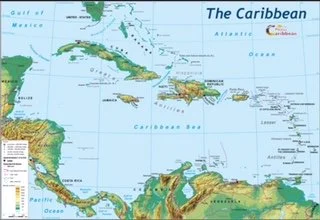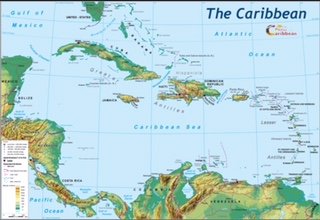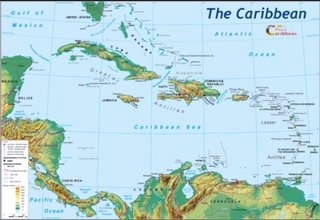The relationship between Spain and the Caribbean is one of the oldest and most profound connections in the region’s history. Spain was the first European power to arrive in the Caribbean, shaping the islands’ languages, cultures, and governance systems. Today, this connection continues through economic ties, cultural exchanges, and diplomatic relations between Spain and Caribbean nations.
Spain’s Arrival in the Caribbean
Spain’s involvement in the Caribbean began with Christopher Columbus’s first voyage in 1492, when he landed in the Bahamas, Cuba, and Hispaniola (modern-day Haiti and the Dominican Republic). This marked the beginning of Spanish colonization, which lasted for centuries. Some key historical moments include:
• The Establishment of Spanish Colonies: Spain ruled over most of the Caribbean, including Cuba, the Dominican Republic, Puerto Rico, Jamaica, Trinidad, and parts of the mainland (Venezuela, Colombia, Panama, etc.).
• The Encomienda System: Spain imposed a plantation-based economy that relied on forced Indigenous labor, which later transitioned to the transatlantic slave trade.
• Religious Influence: Spanish missionaries introduced Catholicism, which remains dominant in many Caribbean countries today.
• The Spanish-American Wars of Independence: In the 19th century, Spain lost control of most of its Caribbean territories as nations fought for independence. However, Cuba and Puerto Rico remained Spanish colonies until 1898, when Spain ceded them to the United States after the Spanish-American War.
Cultural Influence: A Spanish-Caribbean Identity
Even after decolonization, Spanish culture remains deeply embedded in the Caribbean, influencing language, religion, traditions, and daily life.
1. Language
• Spanish is the most widely spoken language in the Caribbean, with over 20 million speakers across:
• Cuba
• Dominican Republic
• Puerto Rico (a U.S. territory with Spanish as its primary language)
• Spanish also influenced Papiamento (spoken in Aruba, Curaçao, and Bonaire) and certain local dialects in non-Spanish-speaking Caribbean islands.
2. Religion
• Roman Catholicism, introduced by Spain, remains a dominant religion in Spanish-speaking Caribbean nations.
• Spanish-influenced religious traditions, such as fiestas patronales (patron saint festivals), are widely celebrated.
3. Architecture and City Planning
• Spanish colonial cities, such as Havana (Cuba), Santo Domingo (Dominican Republic), and San Juan (Puerto Rico), feature plazas, cathedrals, and colonial forts that reflect Spanish architecture.
4. Cuisine
• Caribbean cuisine retains strong Spanish influences, with dishes like:
• Ropa vieja (shredded beef stew – Cuba, Puerto Rico, Dominican Republic)
• Mofongo (fried plantain dish – Puerto Rico, Dominican Republic)
• Paella-style seafood dishes
• Arroz con pollo (chicken and rice)
5. Music and Dance
• Spanish rhythms merged with African and Indigenous influences, giving rise to Caribbean musical genres such as:
• Salsa (Cuba, Puerto Rico, Dominican Republic)
• Merengue (Dominican Republic)
• Bachata (Dominican Republic)
• Reggaeton (Puerto Rico, now popular worldwide)
Spain’s Modern Relationship with the Caribbean
Spain remains an active diplomatic and economic partner to the Caribbean, maintaining strong ties with both Spanish-speaking countries and other Caribbean nations.
1. Economic and Trade Relations
• Spain invests heavily in Caribbean tourism, especially in Cuba, the Dominican Republic, and Puerto Rico.
• Spanish hotel chains, such as Meliá, Barceló, and Iberostar, operate in Caribbean destinations.
• Spain is a major importer of Caribbean products, including rum, sugar, coffee, and seafood.
2. Diplomatic and Cultural Cooperation
• Spain is a key partner in Latin American and Caribbean organizations, such as:
• The Ibero-American Summit, which promotes economic and cultural ties between Spain and former colonies.
• The European Union’s Caribbean initiatives, where Spain plays a role in supporting trade agreements and development aid.
• Spanish cultural centers, such as the Instituto Cervantes, promote Spanish language and culture across the Caribbean.
3. Migration and People-to-People Ties
• Many Caribbean nationals have Spanish ancestry, particularly in Cuba, the Dominican Republic, and Puerto Rico.
• Spain has a large Caribbean diaspora, with many Dominicans, Cubans, and Puerto Ricans living in Spain.
The Spanish-Caribbean Relationship Today
Despite Spain no longer being a colonial power in the region, its historical, cultural, and economic influence remains strong. The ties between Spain and the Caribbean continue to evolve, with cooperation in tourism, trade, education, and cultural exchanges strengthening relationships.
Conclusion
The Spanish connection to the Caribbean is one of the most significant and lasting relationships in the region’s history. From the era of colonization to modern-day diplomatic and economic partnerships, Spain’s influence is deeply woven into the Caribbean’s language, culture, and identity. As the region moves forward, Spain remains a key partner in shaping the Caribbean’s economic growth and cultural development.




